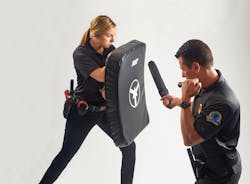The Philosophy Behind Integrated Training
Hess says that integration is key to everything the company does, both on the product side and training side: “There is plenty of training available out there for a single weapon or tool on its own, but that skill isolation doesn’t reflect the way things usually go on the street. Encounters aren’t static, they are fluid and dynamic—it’s called a use of force continuum for a reason.”
In addition to the integrated curriculum itself, there’s something else that is unique about ASP training—it’s free. Law enforcement agencies, officers and other qualified candidates don’t pay for the course, the books, or even the gear they get to use and keep at the end of the three days. ASP provides the trainers, pays their travel expenses, supplies all the equipment and handles all the logistics. ASP Vice President Michael Hess explains that “we feel that free training is part of the obligation we have to law enforcement, and helps to ensure that our training programs are never driven by any bottom line other than officer safety.”
Each ASP Instructor Certification course (AIC) enrolls 35-50 students, taught by two ASP Trainers, all of whom are current or past law enforcement officers.
Last year, ASP conducted its 500th AIC, bringing the total number of current certified ASP Instructors to nearly 50,000, in 104 countries. The company expects to conduct between 60 and 80 AIC trainings in 2019.
More information and current class schedule can be found at ASP-USA.com/Training-Programs.
Harmon—a former police officer, a current Trainer—oversees the program. He explains that ASP’s integrated training begins with specific instruction on each of the three tools, but then moves into how they interact in the real world. “We spend a lot of time on transitions—moving between baton, light and restraint, in a variety of different combinations, and doing so safely and smoothly,” he says. A typical skill and drill progression might start with a baton strike or the use of the flashlight to gain tactical advantage, then move immediately to commanding a subject to the ground and safely handcuffing him.
Techniques are taught and practiced with a variety of different types of baton, restraint and light, and include important ancillary skills like unholstering/uncasing and holstering/casing equipment during a confrontation without losing visual contact or physical control. Each skill and progression is demonstrated, then practiced at slow speed, then executed repeatedly in a fast-paced, physically-demanding set of drills that comprise most of the training time.
Repeatability and efficacy—especially under physical, mental and environmental stress—are critical. “Complexity is the enemy of effectiveness and safety,” says Harmon. “We teach simple, instinctive movements that use gross motor skills; not complex, detailed choreography that is unlikely to be remembered—much less effectively implemented—on the street.” Hess points out that this is an area in which the company’s training informs its products, and vice-versa. “virtually everything we make is designed for one-hand use, typically with one mechanical interface, and without having to take your eyes off the subject.” He says that ASP Trainers have a lot to say about whether a new product makes it to market or not. “If it doesn’t fit with our simple, practical training philosophy, we don’t want to put it on an officer’s duty belt.”
And yes, offers do fail the training. ASP believes that when officer safety is involved, training credentials must be worked for and earned. Graduation and certification are not a given at AIC courses. “That said,” says Hess, “it is always our goal to send everyone back to their agencies as Certified Instructors, and all of the ideas and practices of our training programs lend themselves to success as a student, teacher and officer.”
